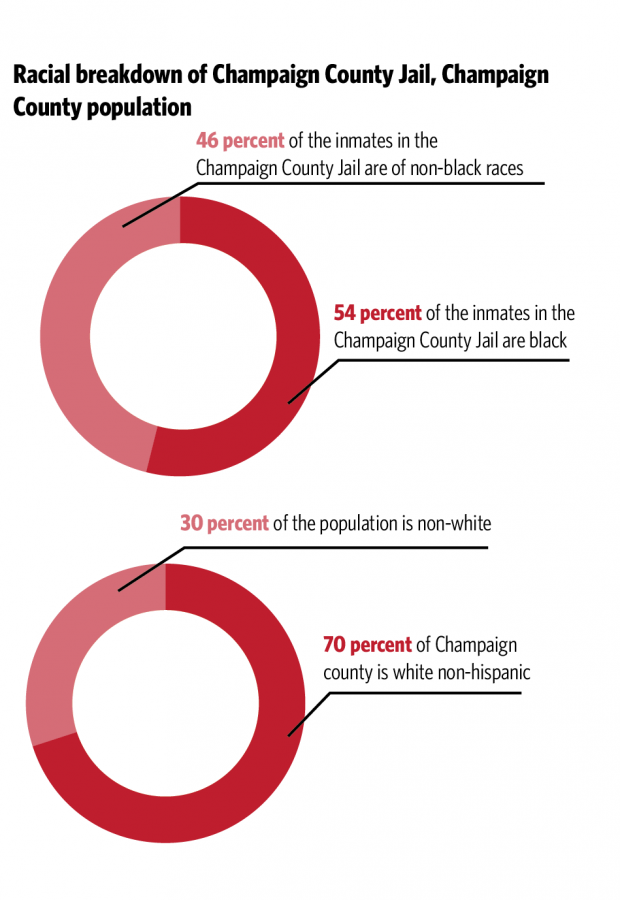Racial disparity persists in Champaign law enforcement system
Source: Champaign County Jail Records and U.S. Census Bureau
April 23, 2018
“Eager” is a word that makes Amy Felty, a member of the Champaign Human Relations Commission, cringe when she hears it used to describe new recruits at the Champaign Police Department. She can’t help but wonder what makes them so excited about making arrests. Felty thinks this attitude is due to a problematic race concept known as implicit bias.
In October 2017, the Champaign County Racial Justice Task Force issued an inmate report two years in the making. The task force was originally created as a result of the 2012 proposal to start a $20-million renovation on the Champaign County Jail, expanding it to hold more inmates, according to the RJTF.
Some people in the community were upset by the proposal and protested the jail’s decision. One organization, Build Programs Not Jails, rose from the debate.
James Kilgore, member of Build Programs Not Jails, considers himself to be anti-incarceration, meaning that he believes the jail system should reduce its inmate population.
Kilgore said he believes any money spent on reconstructing the jail would be better spent on programs to keep people out of jail in the first place. One of the main issues Kilgore believes the criminal justice system should find a solution to is the mass incarceration of people who do not need to be in jail, specifically black people who do not.
Get The Daily Illini in your inbox!
According to the Champaign County Jail records, a large amount of bookings and people incarcerated are serving time for crimes that do not typically have jail time as a punishment. Instead, these people are serving time because they could not afford to pay their bond to be released.
Over time, the debate became less about the controversy of a jail expansion and more about the apparent racial and socioeconomic disparities within the Champaign criminal justice system, Kilgore said.
“We have structures that, in many ways, disproportionately criminalize people of color,” said Sam Byndom, co-chair for RJTF.
Byndom describes this system by using steps. He said that at every step in the judicial system — policing, judging and jailing — there are discriminatory procedures taken to punish black people and let white people off with a warning.
From January 2007 to March 2018, 81,716 people have been booked by the Champaign jail, and 37 percent of these people have been white non-hispanics, according to the Champaign County Jail official records.
According to the U.S. Census Bureau, about 70 percent of Champaign County is white and non-hispanic as of 2016. About 30 percent of the population makes up other races; however, this category makes up about 63 percent of the Champaign jail. The RJTF sees this as an obvious racial disparity.
“When we talk about implicit bias, it doesn’t come from thin air,” Byndom said. “We have systems of oppression that have been in place for hundreds of years. Most people aren’t willing or able to engage in those conversations, about the racialization, about the way in which it is that race operates within the local context.”
Byndom said in order for the community to counteract its implicit bias, it needs to see it as a real issue. Byndom said this is a problem because most people don’t care enough about the disparities to change their mindset.
“I think it’s one thing to say that ‘Yes, the disparities in the criminal justice system are bad. They’re horrible.’ It’s another thing to actually care and begin to implement action which drastically changes it,” Byndom said.
Felty, board member of the RJTF, agrees with Byndom. She said police officers need to understand the predisposed judgements they are making in order to progress as a society.
“We’ve never had equality in this country, ever,” Felty said. “I think we are, as a human race, growing past this, but implicit bias is something that we have to tackle really hard because people have to understand what it is.”
Katie Blakeman, Champaign County circuit clerk, said her office takes the recommendations given in the Racial Justice Report very seriously.
“In our hiring processes, we actively work to make sure our staff reflects the community that we work for,” Blakeman said.
Additionally, Blakeman said the Circuit Clerk’s office actively participates in diversity training for its employees so they understand how to prevent cases of implicit bias.
Kilgore said he finds it difficult to believe that it’s taken society so long to come to an understanding on topics such as racialization and poverty.
“I think Champaign-Urbana has this self-image of it being a very liberal open-minded community, but the reality is that it’s a fairly hard-hearted community when it comes to dealing with issues of poverty and inequality,” Kilgore said.
Felty is confident Champaign can lead other counties in preventing implicit bias within the criminal justice system if the law enforcement system follows the recommendations. She said as times goes on, people become more receptive to new ideas and policing practices. To Felty, society is maturing.
“My goal is that we mature as a community as part of the world that is maturing too,” Felty said. “The human race, I think, is maturing.”







